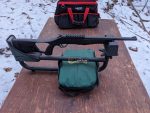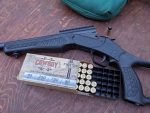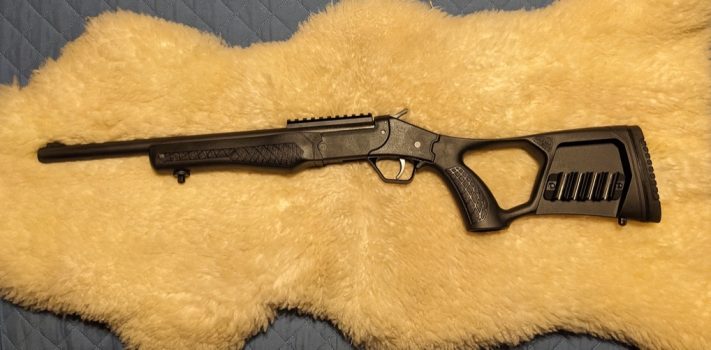Packing considerably more punch than the typical .22LR survival rifle, the Rossi Survival Rifle in .45 Colt/.410 Gauge is light, compact, rugged, and easy to use. It would be an excellent tool for taking medium-sized game out to about 75 yards or so. Beyond that range, the trajectory of the bullet from a .45 Colt cartridge begins to exhibit its bow-shaped arc, making accurate shooting more difficult.
With a manufacturer-suggested retail price of $356.99 at the time of this writing at www.rossiusa.com, the rifle would make an excellent addition to the survival kit of a plane, boat, truck or other vehicle that spends a lot of time in the backcountry.
Background
I own a Howell Arms conversion cylinder for my Pietta M1858 cap and ball revolver. That cylinder is chambered in .45 Colt. Since I already have ammunition on hand for that revolver, I find rifles chambered for that cartridge to be especially attractive from a logistics point of view.
When I ran across the Rossi Survival Rifle in .45 Colt/.410 Gauge, my interest was piqued. Like the Taurus Judge and similar handguns, the rifling in the barrel keeps the firearm from being classed as a rifle rather than as a short-barreled shotgun even though the 16-inch length of the barrel is shorter than the minimum of 18 inches required for a NFA-compliant shotgun. I wondered how accurate the firearm would be as a rifle. I also wondered how Rossi prevented the rifling from creating a donut hole in the middle of a shotshell pattern.
I decided that the best way to find the answers to these questions was to test the rifle for myself. I contacted Rossi, and asked if I could borrow a sample for testing and evaluation. They were kind enough to agree. Not long afterward, I got a call from the gun store that handles my firearms transfers letting me know that the Survival Rifle had arrived.
First Impressions
My very first impression was surprise at the small size and light weight of the box containing the rifle. I knew the rifle was small, but I did not realize quite how small it truly was until I saw the box.
 The box was so small that I thought the rifle might be broken down inside the box. That was not the case. The box contained the fully assembled rifle in a plastic bag, an extra choke tube and choke key, a trigger lock, a manual, and a couple of NSSF safety brochures regarding general firearms safety and safe firearms storage in the home.
The box was so small that I thought the rifle might be broken down inside the box. That was not the case. The box contained the fully assembled rifle in a plastic bag, an extra choke tube and choke key, a trigger lock, a manual, and a couple of NSSF safety brochures regarding general firearms safety and safe firearms storage in the home.
The barrel appeared dirty from test firing at the factory, and the firearm in general was generously oiled to prevent corrosion during storage and shipment.
The rifle comes with sling studs installed, iron sights, and a Picatinny rail for optics installation.
The black synthetic furniture includes a holder for 4 extra rounds of ammunition on each side of the buttstock.
The rifle is a break-open single-shot with an external hammer and a through-receiver-safety behind the trigger. The hammer cannot be cocked when the safety is engaged.
A lever that is flush with the receiver is located to the right of the hammer. This lever allows the rifle to be broken open for loading and unloading.
Reading the Manual
Although firearms manuals do not usually provide the most exciting reading, they do provide some highly important information. Here are some of the highlights of this well-written and well-illustrated manual:
The manual begins with the basic rules of firearms safety. It is wise to put this important information near the beginning. Some firearms manuals begin with statements mandated by various state governments. That bureaucratic legalese generally causes the readers’ eyes to glaze over before they can absorb any useful information.
- It is not safe to fire +P, +P+, or .454 Casull ammo in this rifle.
- The rifle has a transfer bar to help prevent accidental discharge if the hammer is struck without the trigger being pulled.
- The rifle cannot be broken open while cocked.
- The decocking directions in the manual are inaccurate. They indicate that the safety should be in the “on” position prior to decocking. It is actually necessary for the safety to be in the “off” position in order to allow decocking.
- The thread protector choke needs to be used when firing .45 Colt or .410 slugs. The straight rifled choke needs to be used when firing shotshells.
- For cleaning, the manual recommends merely opening the breach. The rifle can be broken down further for transport or storage.
- The manual includes a nice exploded drawing and parts list.
- The one-year limited warranty applies only to the original owner, and is voided by the use of reloaded ammunition.
Trigger Pull Weight
I tested the trigger pull weight using a Ready Up Gear Digital Trigger Pull Weight Gauge. I measured the trigger pull weight five times. The trigger pull weight varied between 4.54 pounds and 5.06 pounds, with an average of 4.81 pounds and a median of 4.83 pounds.
Since the Survival Rifle is based on the same action as the Rossi’s Brawler single-shot handgun, it is not surprising that the trigger pull weight of the rifle is somewhat handgun-like. But the trigger broke smoothly enough that I never noticed its slightly heavier weight during my range testing.
Range Session 1

 It was an unseasonably mild evening in late February. The temperature was 47 degrees Fahrenheit with no discernible breeze. The only evidence of the winter season was some remaining snow, and the quick fading of light in early evening. I set up a target stand in front of the backstop on the improvised range behind my pole barn. I set up a table 25 yards away, and placed a lead sled on the table.
It was an unseasonably mild evening in late February. The temperature was 47 degrees Fahrenheit with no discernible breeze. The only evidence of the winter season was some remaining snow, and the quick fading of light in early evening. I set up a target stand in front of the backstop on the improvised range behind my pole barn. I set up a table 25 yards away, and placed a lead sled on the table.
I then proceeded to fire a number of 3-shot groups using Fiocchi Cowboy Action 250 grain LRNFP ammo and Herter’s Target 250 grain lead flat nose ammo. The Fiocchi groups ranged from 2.55 to 3.55 inches in size, while the Herter’s groups ranged from 4.55 to 5.55 inches in size.
I felt that this less than stellar accuracy was due primarily to aging eyes using iron sights in fading light. I decided that I should follow up with a subsequent range session using a scope.
Patterning
I switched to the straight rifled choke so that I could pattern the rifle using shotshell. I fired at my target from 20 yards using Winchester Super Speed 2 ½ inch shotshell loaded with ½ ounce of number 6 shot.
The 32 inch diameter of the resulting pattern would be typical of cylinder bore.
There was an 8 inch donut hole in the middle of the pattern with just one pellet hole in the middle. This would suggest that the straight rifled choke was not fully able to overcome the disruptive influence that the rifling in the barrel had on the shot. A hole this large in the center of the pattern would discourage me from using the Survival Rifle with shotshell.
Cleaning
 I cleaned the Survival Rifle by running patches with OGRE Manufacturing EnviroClean FA Gun Cleaner through the bore until one came through clean. This was followed by a dry patch. I used the same process on the external metal surfaces. I then ran a patch with Breakfree CLP through the bore, and applied a thin film of CLP to the external metal surfaces.
I cleaned the Survival Rifle by running patches with OGRE Manufacturing EnviroClean FA Gun Cleaner through the bore until one came through clean. This was followed by a dry patch. I used the same process on the external metal surfaces. I then ran a patch with Breakfree CLP through the bore, and applied a thin film of CLP to the external metal surfaces.
Mounting a Scope
I attached Leupold medium Rifleman Rings on the picatinny rail, and then mounted a Leupold VX-Freedom 3-9X40mm Hunt Plex Scope in the rings. I found that the rings were low enough that the spur of the hammer came into contact with the scope when the rifle was dry fired.
I switched to a slightly taller generic set of rings that had come with an inexpensive scope that I purchased some years back. The generic rings were high enough for the spur of hammer to clear the scope.
I then leveled the scope, and tightened the rings evenly.
Range Session 2
It was a beautiful, sunny, unseasonably warm afternoon in late February. The temperature was 53 degrees Fahrenheit. A moderate wind was blowing from the east.
I fired a number of 3 shot groups using Fiocchi Cowboy Action 250-grain LRNFP ammo. The groups ranged from 1.05 to 1.3 inches in size, with an average of 1.15 inches and a median of 1.11 inches.
So using a scope did allow me to achieve significantly better results than my aging eyes were able to manage utilizing iron sights. These results confirmed that the Survival Rifle is usefully accurate within the effective range of the .45 Colt cartridge.
Conclusions
The Rossi Survival Rifle in .45 Colt/.410 Gauge is a compact, lightweight, rugged firearm chambered for a highly useful cartridge. The .45 Colt cartridge was originally designed to be loaded with black powder, and to be powerful enough to kill a horse at 100 yards. Although the accuracy of the .45 Colt cartridge diminishes significantly past 75 yards or so, the Survival Rifle should be effective at taking medium sized game out to that range.
I did not find the rifle to pattern well enough with shotshell to be effective for use with upland game. If I included this rifle in a survival kit, I would pack extra .45 Colt ammo, and leave the .410 shotshell home.
Disclaimer
Rossi was kind enough to loan me a sample of the Survival Rifle for testing and evaluation. Ready Up Gear had provided me with a sample of their Digital Trigger Pull Weight Gauge for an earlier review. Fiocchi had provided me with a supply of their .45 Colt Cowboy Action Ammo for an earlier review. OGRE Manufacturing had provided me with a sample of their EnviroClean FA Gun Cleaner for an earlier review. I tried not to allow the kindness of these vendors to interfere with the objectivity of my review, and feel that I have succeeded. I did not receive any other financial or other inducement to mention any vendor, product, or service in this article.










